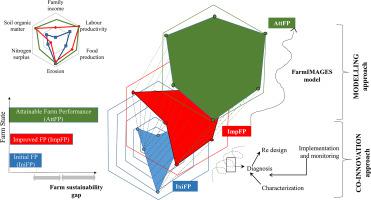Agricultural Systems ( IF 6.1 ) Pub Date : 2020-12-25 , DOI: 10.1016/j.agsy.2020.103017 P. Colnago , W.A.H. Rossing , S. Dogliotti

|
In Uruguay sustainability of family farm systems is threatened by soil degradation, low yields and excessive workloads resulting in low labour productivity, low family income and high erosion rates. The productive and environmental performances of most Uruguayan family farms are well below levels achievable with current resource availability. This paper aims to show the productive and environmental improvements simultaneously possible by addressing resource management and organization of the farm system as a whole. We report results from two learning cycles on 4 case study farms and address their interdependence. The first cycle involved on-farm re-design in a co-innovation process that led to significant improvements in the performance of the case study farms. The insights gained during co-innovation work were used to parameterize a bio-economic whole-farm model to explore the space for further performance improvement and to inform future co-innovation processes. The two learning cycles characterized three farm performance levels: the initial farm performance (IniFP), representing the state of the farm at the start of co-innovation, the improved farm performance (ImpFP) at the end of co-innovation, and the attainable farm performance (AttFP) estimated with the FarmImages model. Difference between ImpFP and AttFP represent the sustainability gap. After three years of co-innovation, family income on the four farms improved by 16 to 350%, while labour productivity increased by 11% to 214%. Model explorations showed that significant further improvement in socio-economic results was possible while maintaining soil erosion under the tolerance level. The strategies identified differed among the four farms depending on their resource endowment and the technologies available, confirming the need for a systemic perspective and tailor-made solutions. We show how an inclusive whole-farm approach comprising co-innovation and model-based explorations contributes to connecting scientific insights with practical contextualization to close sustainability gaps on family farms.
中文翻译:

弥合家庭农场的可持续性鸿沟:结合农场共同创新和基于模型的探索
在乌拉圭,土壤退化,单产低下以及工作量过多,都威胁着家庭农业系统的可持续性,从而导致劳动生产率低,家庭收入低和侵蚀率高。大多数乌拉圭家庭农场的生产和环境绩效远低于现有资源可获得的水平。本文旨在通过解决整个农场系统的资源管理和组织问题,来展示生产和环境同时改善的可能性。我们报告了来自4个案例研究农场的两个学习周期的结果,并解决了它们之间的相互依赖性。第一个周期涉及在共同创新过程中对农场进行重新设计,从而导致案例研究场的性能得到显着改善。在联合创新工作中获得的见解被用于参数化生物经济全农场模型,以探索进一步改进绩效的空间,并为未来的联合创新过程提供信息。这两个学习周期表征了三个服务器场绩效级别:初始服务器场绩效(IniFP),代表联合创新开始时的服务器场状态;联合创新结束时改进的服务器场绩效(ImpFP),以及可达到的水平使用FarmImages模型估算的农场绩效(AttFP)。ImpFP和AttFP之间的差异代表了可持续性差距。经过三年的共同创新,四个农场的家庭收入提高了16%至350%,而劳动生产率提高了11%至214%。模型探索表明,在将土壤侵蚀保持在公差范围内的同时,有可能进一步显着改善社会经济结果。根据四个农场的资源among赋和可用技术,所确定的策略有所不同,这确认了需要系统的观点和量身定制的解决方案。我们展示了包括联合创新和基于模型的探索在内的包容性全农场方法如何有助于将科学见解与实际环境联系起来,以缩小家庭农场的可持续性差距。











































 京公网安备 11010802027423号
京公网安备 11010802027423号